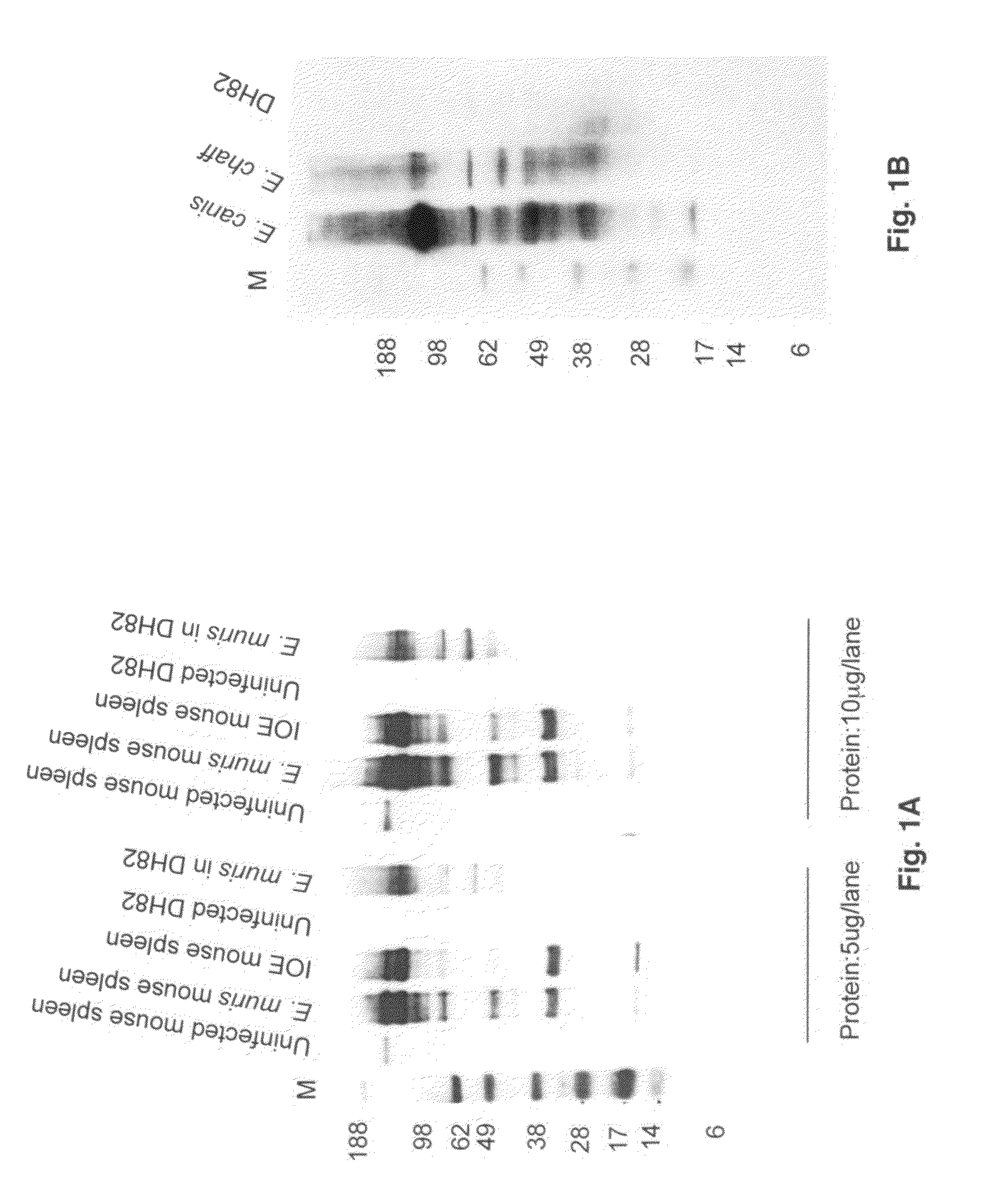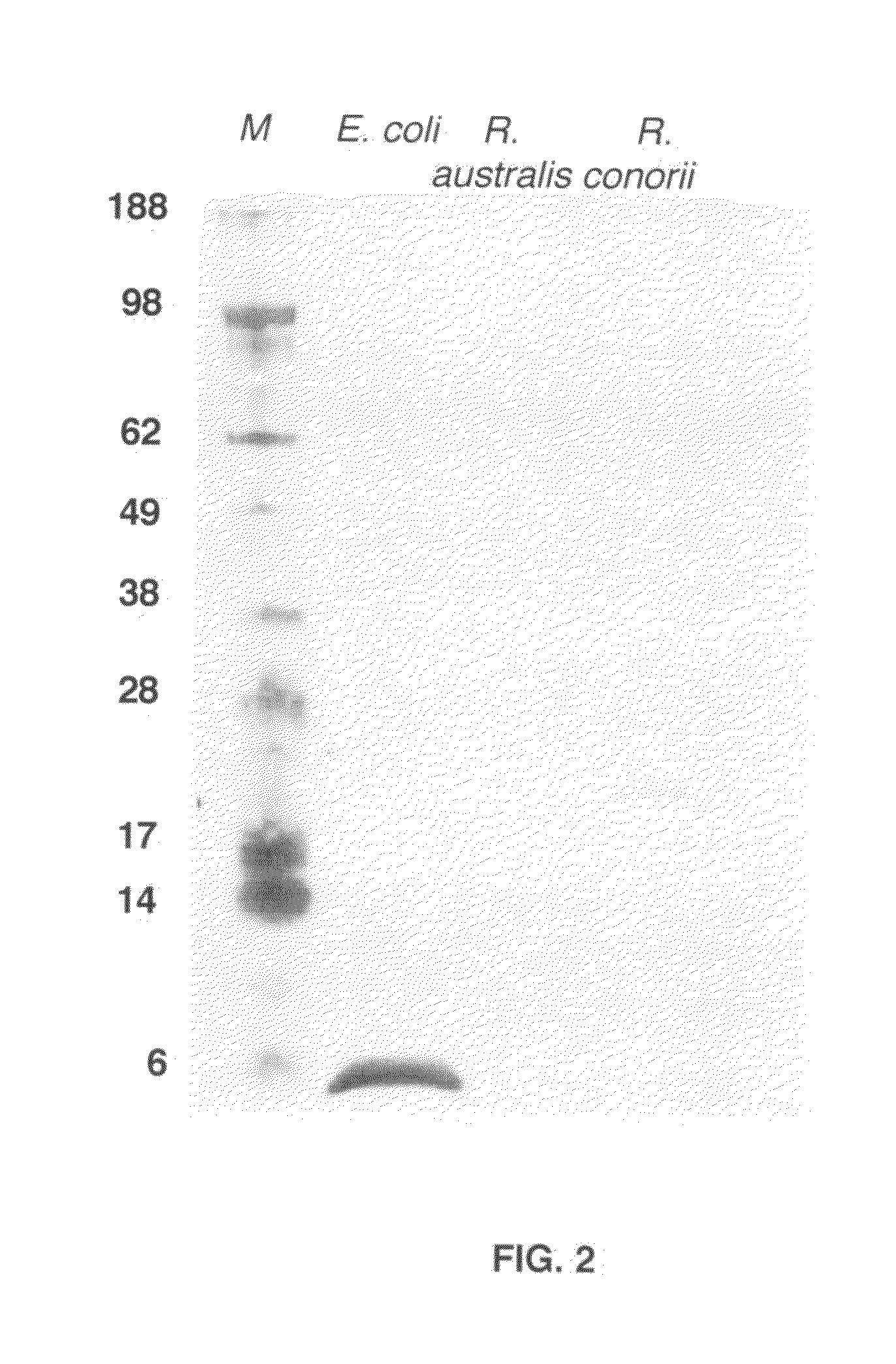Method of diagnosing and treating Ehrlichia
a technology of ehrlichia and diagnostic methods, applied in the field of microbiology, bacteriology and molecular biology, can solve the problems of increasing the difficulty of diagnosing severe and sometimes fatal illness, and increasing the difficulty of immune compromised and elderly people to detect organisms by these methods, etc., to achieve the effect of raising antibodies and inducing network cross reactivity
- Summary
- Abstract
- Description
- Claims
- Application Information
AI Technical Summary
Benefits of technology
Problems solved by technology
Method used
Image
Examples
example 1
Design of Hsp60 Peptide
[0075]When examining a protein sequence for potential antigenic epitopes, it is important to choose sequences that are hydrophilic, surface-oriented, and flexible. Most naturally occurring proteins in aqueous solutions have their hydrophilic residues on the protein surface and hydrophobic residues buried in the interior. This optimization is based on the fact that antibodies tend to bind to epitopes on the protein surface. Additionally, it has been shown that epitopes have a high degree of mobility. When designing a peptide for antibody production, the first task is to decide upon the desired location of the antibody binding site on the protein of interest. Hydropathy plots of the amino acid sequence can be performed to determine the hydrophilicity of various regions of the protein (Kyte and Doolittle, 1982). Because hydrophilic regions are more likely to be exposed on the protein, an anti-peptide antibody to a hydrophilic sequence will be more likely to recog...
example 2
Generation of Hsp60 Antibody and Western Blotting
[0078]All the three peptides were conjugated to KLH (Biosynthesis, Texas) and 200 micrograms of each peptide was injected to 5 mice. Mice were injected with a initial dose of Hsp60 peptide combined with Freund's complete adjuvant and two doses of peptide combined with Freund's incomplete adjuvant. Injections were given 15 days apart and blood collected after 15 days of the last injection.
[0079]For western blotting, E. muris, E. canis and E. chaffeensis were cultivated in DH82 cells at 37° C. in DMEM supplemented with 5% heat inactivated bovine calf serum. Ehrlichiae were harvested when approximately 90 to 100% of the cells were infected. To produce infectious stocks for western blotting, C57BL / 6 mice were inoculated i.p. with 1 ml of a 10−1 dilution (5×108 E. muris or IOE) of the frozen stock. On day 7 after inoculation, the mice were sacrificed, the spleens were harvested, and splenic homogenate was prepared and suspended in DMEM med...
example 3
Immunomicroscopy for the Detection of Ehrlichia
[0080]For immunomicroscopy, DH82 infected with E. muris or E. chaffeensis or splenocytes from mouse infected with E. muris and IOE were used. After fixation both E. muris- and E. chaffeensis-infected DH82 cells were probed with the Hsp60 antibody (1:125) (45 min) and after several washes they were reacted with anti-mouse immunoglobulin G conjugated to Alexa 488.
Example 4
Synthesis of a Novel Peptide for the Production of Antibody to Detect Ehrlichia
[0081]Of the three peptides synthesized for the production of antibody only the peptide corresponding to the amino acid 43-63 of the Hsp60 protein elicited antibody production in mice. The sequence of the Hsp60 peptide is: YGAPEITKDGYKVIKSIKPED (SEQ ID NO. 2)
TABLE 2Analysis of the peptide showed homology to other Ehrlichial species
TABLE 3BLAST analysis of the Hsp60 peptide.Sequences producing significant alignments:(Bits)Valuegb|DQ672553.1| Candidatus Ehrlichia ovata groESL operon, part . . ....
PUM
| Property | Measurement | Unit |
|---|---|---|
| Fraction | aaaaa | aaaaa |
| Fraction | aaaaa | aaaaa |
| Fraction | aaaaa | aaaaa |
Abstract
Description
Claims
Application Information
 Login to View More
Login to View More - R&D Engineer
- R&D Manager
- IP Professional
- Industry Leading Data Capabilities
- Powerful AI technology
- Patent DNA Extraction
Browse by: Latest US Patents, China's latest patents, Technical Efficacy Thesaurus, Application Domain, Technology Topic, Popular Technical Reports.
© 2024 PatSnap. All rights reserved.Legal|Privacy policy|Modern Slavery Act Transparency Statement|Sitemap|About US| Contact US: help@patsnap.com










